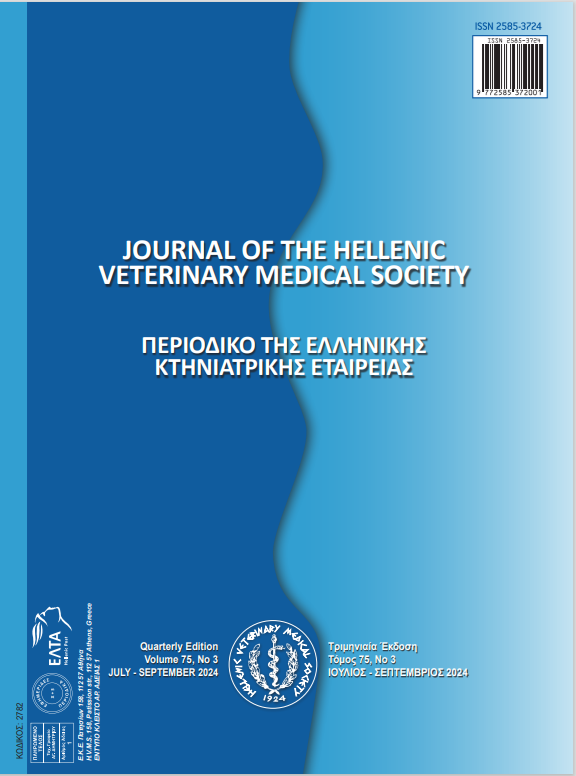Histopathological, Immunohistochemical and Molecular Detection of Toxoplasma gondii in Organs and Tissues of Experimentally Infected Mice

Περίληψη
Purpose: Toxoplasmosis is a multisystemic disease of Toxoplasma gondii, an obligate intracellular protozoan that can affect all vertebral organisms. The aim of this study is to determine the distribution rate histopathologically, immunohistochemically and molecularly with mouse experiments.
Methods: In our study, T. gondii TR01 tachyzoites were injected intraperitoneally into Specific Pathogen Free, 3-4 weeks old, 17-18 gr healthy white male Swiss-Albino mice. Two mice were euthanized daily and the distribution of the parasite was determined in daily concentrations in blood, peritoneal fluid, liver, kidney, heart, lung, intestine and central nervous system sections.
Results: As a result of the histopathological analyzes, mild necrosis and degeneration of hepatocytes were observed in the liver on the 1st day. Tachyzoites are common in central regions. Degeneration was observed in the cortical and corticomedullary tubular epithelium in the kidney. Slightly degeneration of cardiomyocytes was observed in the heart. Regional hyperemic capillaries were found in the lung. Degeneration of intestinal epithelial cells was observed, and necrosis was not observed in villi and glandular epithelium. In the CNS, cerebral cortical neurons were observed to be affected by degeneration and necrosis. On the 2nd day, degeneration and necrosis of hepatocytes in the liver were observed moderately compared to the previous day. Degeneration of cortical and medullary tubules was more common in the kidney. Mild necrosis and degeneration were observed in some villi epithelium in the intestine. Lesions on day 3th were as on day 2th of the experiment. Degeneration and necrosis were detected in the renal tubules. The lung was more hyperemic. Degeneration and necrosis were more prominent in the cortical neurons of the brain. Lesions on day 4th were the same as on days 2th and 3th of the experiment. On the 5th day, the parasite was found to be less than the degeneration and necrosis of the tubules in the kidney tissue.
In immunohistochemical staining, reactions were mostly found in liver, kidney, and intestine, while relatively low levels were found in lung, heart, and brain.
RT-PCR targeting the T. gondii B1 gene region molecularly was used. All tests were positive except day zero in RT-PCR. The CT value and the lower values indicate the areas with the highest density. On the first day and on the last day, it is mostly found in the liver, lung and peritoneal fluid. At least, it spread to the brain and heart.
Conclusion: Factors such as host cell type, infection rate, susceptibility, route of administration, and host and tissue selection of the parasite affect the virulence of the T. gondii strain. Knowing which strain caused the infection may be useful in predicting the outcome of organ involvement and virulence. The death of all mice within 6 days in our study indicates that the T. gondii TR 01 strain is a highly aggressive and lethal agent for mice.
Histopathological, immunological and PCR spread to the CNS was found to be minimal. This is thought to be because the infective agent is less able to cross the CSF barrier. Tissue cysts were not found in all tissues. T. gondii infects the liver first in all three studies and remains in high concentration until death. Low spread to the heart is also similar to other studies. Desquamation and leukocytosis were not observed in the lung alveoli in our study. The liver, kidney and peritoneal fluid are most affected, and the brain is the least affected. This situation informs us that the parasite invasion in the liver is intense and is in parallel with other studies. Necrosis was detected in all tissues except the intestine.
Toxoplasma gondii has the potential to develop changes by spreading in tissues. In today's world where drug and vaccine studies are increasing rapidly, it is important to know the distribution of the parasite in the tissues and the changes it makes. In this context, it is a parasite that still needs to be investigated together with the parasite strains, which is mandatory and difficult to diagnose and treat.
Λεπτομέρειες άρθρου
- Πώς να δημιουργήσετε Αναφορές
-
Yucesan, B., Kilic, S., Alçıgır, M., Babur, C., & Özkan, Ö. (2024). Histopathological, Immunohistochemical and Molecular Detection of Toxoplasma gondii in Organs and Tissues of Experimentally Infected Mice . Περιοδικό της Ελληνικής Κτηνιατρικής Εταιρείας, 75(2). https://doi.org/10.12681/jhvms.34354
- Τεύχος
- Τόμ. 75 Αρ. 2 (2024)
- Ενότητα
- Research Articles

Αυτή η εργασία είναι αδειοδοτημένη υπό το CC Αναφορά Δημιουργού – Μη Εμπορική Χρήση 4.0.
Οι συγγραφείς των άρθρων που δημοσιεύονται στο περιοδικό διατηρούν τα δικαιώματα πνευματικής ιδιοκτησίας επί των άρθρων τους, δίνοντας στο περιοδικό το δικαίωμα της πρώτης δημοσίευσης.
Άρθρα που δημοσιεύονται στο περιοδικό διατίθενται με άδεια Creative Commons 4.0 Non Commercial και σύμφωνα με την άδεια μπορούν να χρησιμοποιούνται ελεύθερα, με αναφορά στο/στη συγγραφέα και στην πρώτη δημοσίευση για μη κερδοσκοπικούς σκοπούς.
Οι συγγραφείς μπορούν να καταθέσουν το άρθρο σε ιδρυματικό ή άλλο αποθετήριο ή/και να το δημοσιεύσουν σε άλλη έκδοση, με υποχρεωτική την αναφορά πρώτης δημοσίευσης στο J Hellenic Vet Med Soc
Οι συγγραφείς ενθαρρύνονται να καταθέσουν σε αποθετήριο ή να δημοσιεύσουν την εργασία τους στο διαδίκτυο πριν ή κατά τη διαδικασία υποβολής και αξιολόγησής της.



